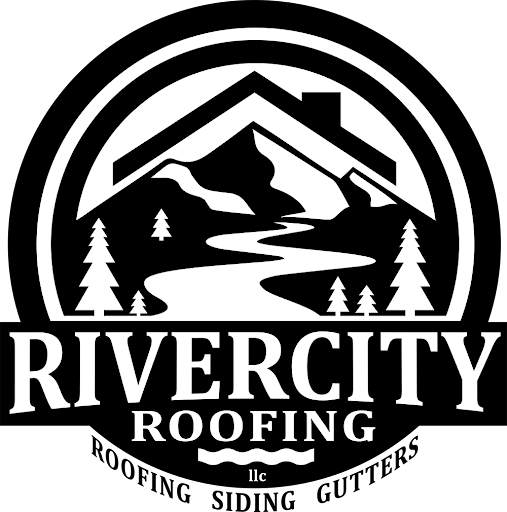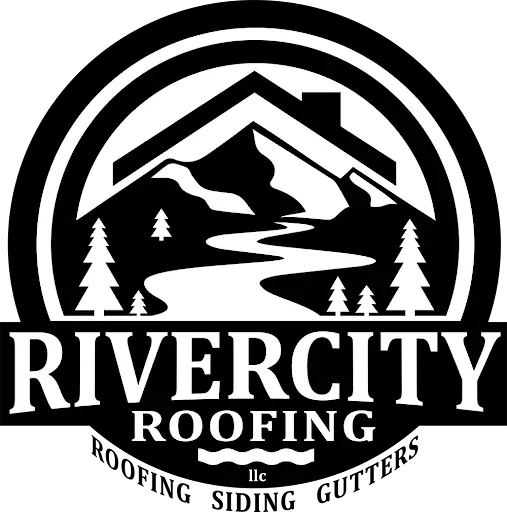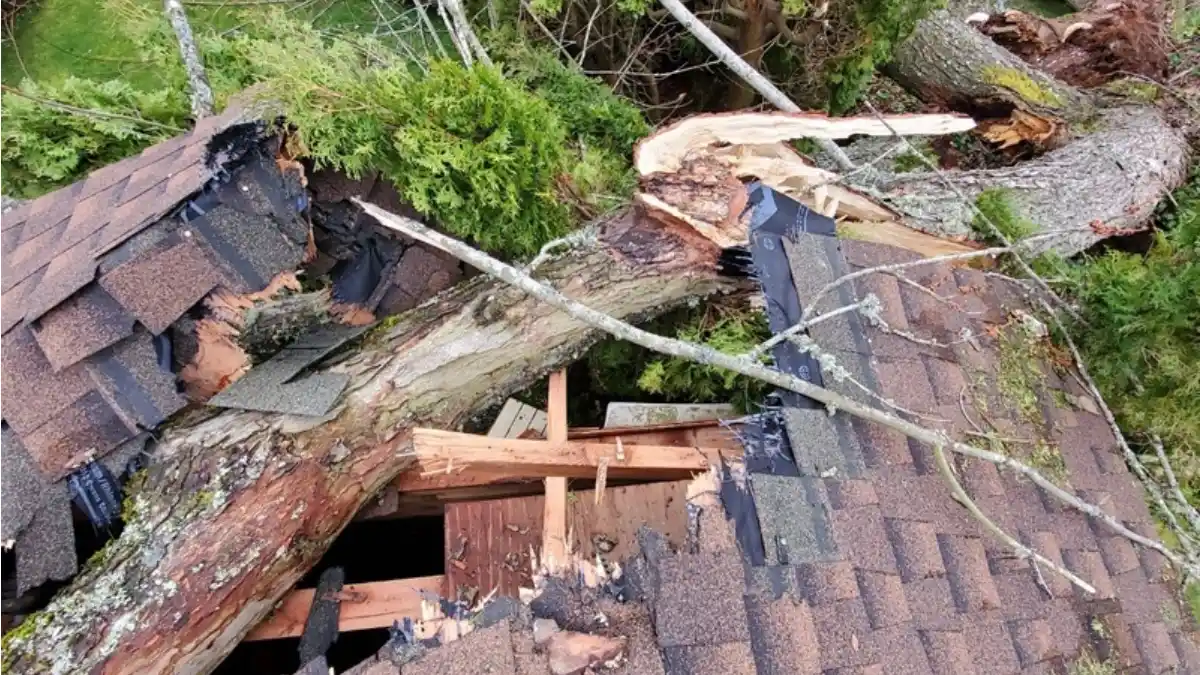Hail storms can wreak havoc on your roof, leading to significant damage that, if left unchecked, can cause costly repairs down the line. A free roof inspection is crucial, especially after severe weather events like hail storms, to assess potential damage and ensure safety. At River City Roofing, we understand the importance of timely and thorough roof inspections following a hail storm. In this comprehensive guide, we’ll walk you through everything you need to know about hail damage roof inspections.
Understanding Hail Damage
What is Hail Damage?
Hail damage occurs when hailstones strike your roof, potentially causing dents, cracks, or even punctures. It is important to promptly inspect properties after a hailstorm to identify hail damage effectively. Early detection can prevent further issues like water leaks and mold growth. The severity of the damage depends on the size, density, and speed of the hailstones, as well as the age and material of your roof. Hailstones as small as a quarter inch can cause damage, but the most severe damage typically comes from stones that are one inch or larger in diameter.
Common Signs of Hail Damage on Roofs
- Dented Shingles: Hailstones can leave noticeable dents or bruises on asphalt shingles, which may eventually lead to leaks.
- Cracked or Missing Shingles: Severe hail can crack or dislodge shingles entirely, exposing the underlying layers of your roof to the elements.
- Granule Loss: Hail impact can dislodge the protective granules on shingles, leading to accelerated aging and reduced effectiveness of the shingles.
- Gutter and Downspout Damage: Dents and punctures in gutters and downspouts indicate potential roof damage and can lead to drainage issues.
- Flashing Damage: Hail can dent or bend the metal flashing around chimneys, vents, and skylights, potentially allowing water to seep into your home.
- Skylight and Vent Damage: Cracks or impact marks on skylights and vents can also indicate hail damage.
Impact of Hail Damage on Roof Longevity
Unaddressed hail damage can lead to water infiltration, mold growth, and structural issues, significantly shortening your roof’s lifespan. Even minor damage can escalate if not repaired promptly, leading to more extensive and expensive repairs in the future.
Free Roof Inspections. Fast. Reliable.
Is your roof ready to weather the storm? Dont risk property damage. Our free roof inspections provide expert analysis to identify potential issues before they become costly problems.
When to Get a Hail Damage Roof Inspection
Best Times to Inspect Your Roof After a Hail Storm
Schedule an inspection as soon as possible after a hail storm to identify and mitigate damage early. Additionally, consider seasonal inspections during hail-prone periods, especially in regions where hail storms are common. Most insurance companies have specific requirements for hail damage claims, including the necessity of a professional inspection.
Importance of Regular Inspections Even Without Visible Damage
Not all hail damage is immediately visible. Regular inspections ensure hidden damage is detected and addressed promptly. Some damage may only become apparent over time as the compromised shingles and other roofing materials deteriorate further.
How to Perform a Hail Damage Roof Inspection
DIY vs. Professional Inspections
While you can perform a basic DIY inspection, hiring a professional roofing contractor offers a thorough and accurate assessment. Professionals are trained to spot subtle signs of damage that an untrained eye might miss. However, if you decide to do a preliminary check yourself, here are some tips:
- Safety First: Always prioritize safety. Use a sturdy ladder and have someone spot you.
- Visual Check: Look for obvious signs of damage from the ground, such as missing shingles or dents in gutters.
- Roof Walk: If it’s safe to do so, walk on your roof to check for soft spots, dents, or granule loss.
- Check Attic: Inspect your attic for signs of leaks or water damage.
Key Areas to Check for Hail Damage
- Shingles: Look for dents, cracks, and granule loss. Pay special attention to the areas where hail hits most directly, typically the sides of the roof that face the prevailing wind. Marking and photographing roof hail damage is crucial for accurate reporting to insurance companies.
- Gutters and Downspouts: Check for dents and punctures. Damage here can indicate the severity of the hail storm.
- Flashing: Inspect for bends and dents around chimneys, vents, and skylights. Compromised flashing can lead to significant water damage if not repaired.
- Roof Vents and Skylights: Examine for cracks and impact marks. Even small cracks can allow water to penetrate your roof and cause damage.
Finding a Hail Damage Inspection Near You
Tips for Searching “Hail Damage Inspection Near Me”
Use search engines or local directories to find reputable inspection services in your area. Look for companies with positive reviews and a proven track record. Online platforms like Google My Business, Yelp, and Angie’s List can provide valuable insights into the experiences of other homeowners.
What to Look for in a Professional Hail Inspection Service
- Experience and Expertise: Ensure the company has extensive experience with hail damage inspections. A reputable roofing contractor should possess expertise in inspecting shingles, flashing, and gutters. Experienced inspectors are more likely to identify all the damage and provide accurate recommendations.
- Certifications and Insurance: Verify that the inspectors are certified and the company is insured. This protects you from liability and ensures that the work meets industry standards.
- Customer Reviews: Read reviews to gauge customer satisfaction and service quality. Look for consistent positive feedback and successful resolution of customer concerns.
Questions to Ask Potential Inspectors
– How long have you been performing hail damage inspections?
– Can you provide references from previous clients?
– What is included in the inspection process?
– Do you offer a detailed written report?
– How do you handle potential disputes with insurance companies?
The Process of a Professional Hail Roof Inspection
What to Expect During an Inspection
A professional inspection typically includes a visual examination, documentation of damage, and recommendations for repairs. Recognizing significant hail damage is crucial, and hiring professional roofing contractors to assess it thoroughly ensures that all affected areas are identified. The inspector will walk around your property, climb onto the roof (if safe and necessary), and use various tools to assess the extent of the damage.
Tools and Techniques Used by Professionals
Inspectors use various tools such as drones, infrared cameras, and moisture meters to detect damage. Identifying storm damage during roof inspections is crucial as it can directly impact insurance claims and the necessary steps for repairs. Drones can provide a comprehensive view of the roof without the need for the inspector to physically walk on it, reducing the risk of accidents. Infrared cameras detect temperature variations that can indicate water intrusion, while moisture meters measure the moisture content in your roof materials.
How Long Does an Inspection Typically Take?
A thorough inspection can take anywhere from one to several hours, depending on the roof’s size and complexity. The inspector will also take the time to explain their findings and answer any questions you may have.
Post-Inspection Steps
Understanding the Inspection Report
The report will detail the extent of the damage, including photos and descriptions. It will also include repair recommendations and an estimate of the repair costs. This report is crucial for filing insurance claims and planning repairs.
Recommended Actions Based on Findings
- Minor Damage: Small repairs may be sufficient to address the damage and prevent further issues.
- Moderate to Severe Damage: Partial or full roof replacement may be necessary. The inspector will provide a detailed explanation of the required repairs and the urgency of each issue.
Getting Estimates for Repairs
Obtain estimates from multiple contractors to ensure fair pricing and quality workmanship. Ensure each estimate includes a detailed breakdown of the work to be performed and the materials to be used. This will help you compare quotes more effectively.
Insurance and Hail Damage
How to File an Insurance Claim for Hail Damage
– Contact your insurance company to report the damage. Provide them with the inspection report and any additional documentation.
– Schedule a visit from the insurance adjuster. Be present during the adjuster’s visit to answer questions and provide additional information if needed.
– Keep records of all communications with your insurance company, including emails, letters, and phone calls.
What to Include in Your Claim
– Detailed description of the damage. Include information from the inspection report.
– Photos and videos of the damage. Visual evidence can support your claim and expedite the process.
– Inspection report. This professional assessment can be critical in validating your claim.
Working with Your Insurance Adjuster
Be present during the adjuster’s visit to answer questions and provide additional information if needed. Provide the adjuster with copies of your inspection report, photos, and any other documentation. If there are discrepancies between the adjuster’s assessment and the inspection report, discuss them and seek clarification.
Preventative Measures
How to Minimize Hail Damage to Your Roof
- Impact-Resistant Shingles: Consider installing shingles rated for hail resistance. These shingles are designed to withstand impact better than standard shingles.
- Roof Inspections: Schedule regular inspections to identify and address vulnerabilities. Regular maintenance can help you catch small issues before they become significant problems. Identifying wind damage is crucial when evaluating shingle condition, as missing or creased shingles can indicate compromised roofing.
- Tree Maintenance: Trim overhanging branches to prevent them from causing additional damage during storms. Falling branches can compound hail damage and create additional repair needs.
Materials and Upgrades to Consider for Hail-Resistant Roofing
- Metal Roofing: Durable and resistant to hail damage. Metal roofs can withstand significant impacts without suffering damage.
- Rubber Roofing: Absorbs impact and reduces damage. Rubber roofing materials are flexible and can absorb the force of hailstones.
- High-Quality Asphalt Shingles: Opt for thicker, more durable shingles that offer better protection against hail. Look for shingles with a Class 4 impact resistance rating.
Regular Maintenance Tips
- Clean gutters and downspouts regularly to ensure proper drainage and prevent water damage.
- Inspect and repair flashing as needed to maintain a watertight seal around roof penetrations.
- Replace damaged shingles promptly to prevent further damage and maintain your roof’s integrity.
Conclusion
Hail damage can significantly impact your roof’s integrity and longevity. At River City Roofing, we emphasize the importance of timely and thorough hail damage roof inspections to protect your home. Don’t wait until it’s too late—schedule an inspection today to ensure your roof is in top condition.
Call us at +1 503-970-5005 or visit our website at River City Roofing to schedule a free consultation and inspection. Let River City Roofing help you keep your roof safe and sound.
FAQs
How Often Should I Get a Roof Inspection After a Hail Storm?
It’s recommended to get an inspection immediately after a hail storm and then regularly, at least once a year, especially in areas prone to severe weather.
Can I inspect my roof for hail damage?
While a basic inspection can be done yourself, a professional inspection is recommended for a thorough assessment. Professionals have the experience and tools necessary to identify all forms of damage accurately.
What Are the Costs Associated with a Hail Damage Roof Inspection?
Inspection costs can vary, but many companies, including River City Roofing, offers free Roof inspections. For paid inspections, costs typically range from $100 to $300, depending on the roof’s size and complexity.
How Long Does It Take to Repair Hail Damage on a Roof?
Repair time depends on the extent of the damage, ranging from a few hours to several days. Minor repairs may be completed quickly, while more extensive damage may require a full roof replacement, which can take several days to a week.
For more information and expert advice, trust River City Roofing—your reliable partner in roof care and maintenance. We are committed to helping you protect your home from the elements and ensuring your roof remains in excellent condition for years to come. Contact us today to learn more about our services and how we can assist you with your hail damage roof inspection and repair needs.



